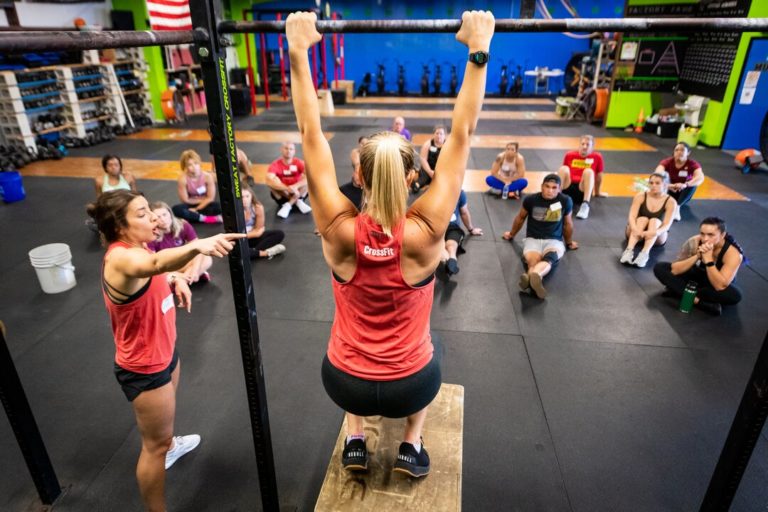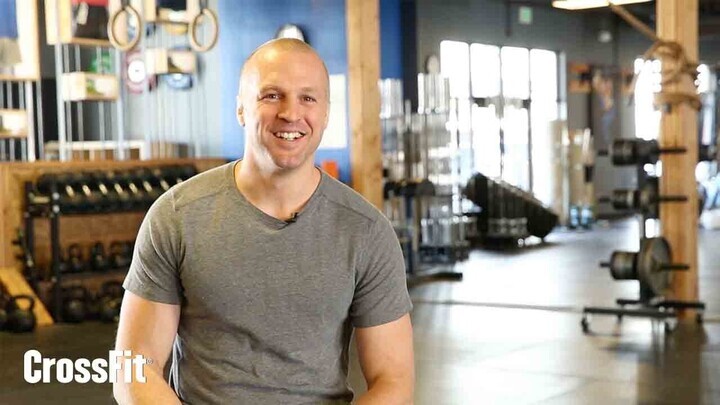Question: How do you efficiently and effectively scale pull-ups for large classes over an entire year?
Scaling gymnastics movements in a large group setting can be challenging. The key to success lies in having a clear, adaptable plan that eliminates guesswork and drives consistent progress.
Here are five strategies for effectively scaling pull-ups to promote long-term development.
#1 – Vary Scaling Options
 Sticking to the same scale every time (e.g., banded pull-ups or ring rows) can lead to plateaus, boredom, and diminished motivation, particularly for athletes with over a year of experience. To keep athletes engaged and progressing, rotate scaling options every few workouts or monthly, as suggested by Pamela Gagnon on a recent webinar. For example, January might focus on ring rows and toe-nail spotted pull-ups, while February shifts to jumping pull-ups and pull-ups with heels on the ground. Flexibility is key, but this rotation can maintain momentum and growth. Check out this post for a few more pull-up variations.
Sticking to the same scale every time (e.g., banded pull-ups or ring rows) can lead to plateaus, boredom, and diminished motivation, particularly for athletes with over a year of experience. To keep athletes engaged and progressing, rotate scaling options every few workouts or monthly, as suggested by Pamela Gagnon on a recent webinar. For example, January might focus on ring rows and toe-nail spotted pull-ups, while February shifts to jumping pull-ups and pull-ups with heels on the ground. Flexibility is key, but this rotation can maintain momentum and growth. Check out this post for a few more pull-up variations.
#2 – Incorporate Scaling in the Warm-Up
For large classes or complex workouts that may demand a lot of instruction (e.g., the snatch), streamline efficiency by integrating scaled pull-up options into the general or specific warm-up. For instance, if you’re using toe-nail spotted pull-ups, your three-step progression could include:
- Step 1: Kip swing (scaled: kips swing with feet on a box)
- Step 2: Kip swing + kip (scaled: kip swing + kip with feet on a box)
- Step 3: Kipping pull-up (scaled: toe-nail spotted pull-up)
#3 – Scale for the Stimulus
Understanding the intended workout stimulus helps guide the right scaling choice. For a high-intensity workout like Fran, jumping pull-ups may be better than banded pull-ups, as they allow quick reps and smooth transitions, maintaining the intensity without unnecessary breaks.
#4 – Use Complexes for Progression
As we stress in the Level 1 Certificate Course, we want athletes to demonstrate strict capacity at pull-ups before they perform kipping pull-ups. However, one way to help athletes advance and add an element of variance is to add kipping elements to the primary scaling option. This was another great suggestion from Gagnon. For example, if a workout has 7 pull-ups per round, an option could be to have the athlete do 7 ring rows plus 7 kip swings or a 10-second bar hang.
#5 – Consider Accessibility
An important factor to consider when running a large class is the complexity of the setup and transitions required. You always want to ensure athletes can move efficiently and safely between movements. For example, if box jumps are part of the workout, jumping pull-ups or toe-nail-spotted pull-ups may not be viable options. As usual, proper planning for the workout and its scaling options can help you nail down logistical issues before you even take the floor.
Applying these strategies enables you to scale pull-ups effectively while promoting long-term athlete development and engagement.
Have a question for a coach? Please submit that here.
About the Author
 Eric O’Connor is a Content Developer and Seminar Staff Flowmaster for CrossFit’s Education Department and the co-creator of the former CrossFit Competitor’s Course. He has led over 400 seminars and has more than a decade of experience coaching at a CrossFit affiliate. He is a Certified CrossFit Coach (CF-L4), a former Division 1 collegiate wrestler, and a former CrossFit Games athlete.
Eric O’Connor is a Content Developer and Seminar Staff Flowmaster for CrossFit’s Education Department and the co-creator of the former CrossFit Competitor’s Course. He has led over 400 seminars and has more than a decade of experience coaching at a CrossFit affiliate. He is a Certified CrossFit Coach (CF-L4), a former Division 1 collegiate wrestler, and a former CrossFit Games athlete.
Ask a Coach: How Do You Efficiently and Effectively Scale Pull-Ups for Large Classes Over an Entire Year?